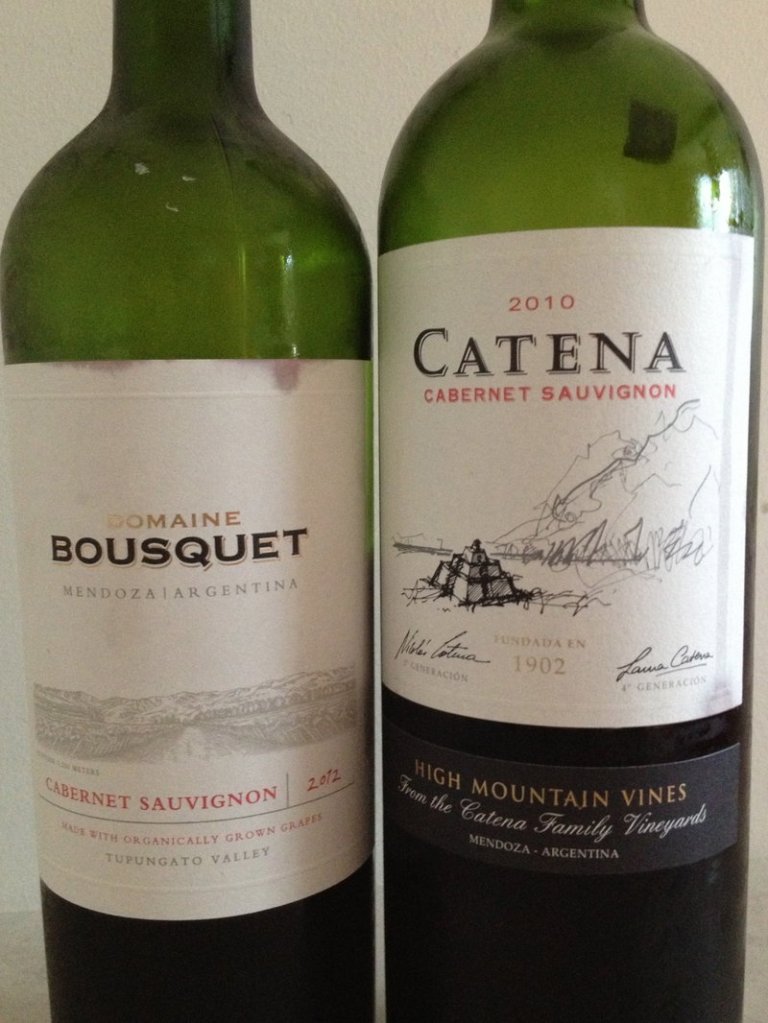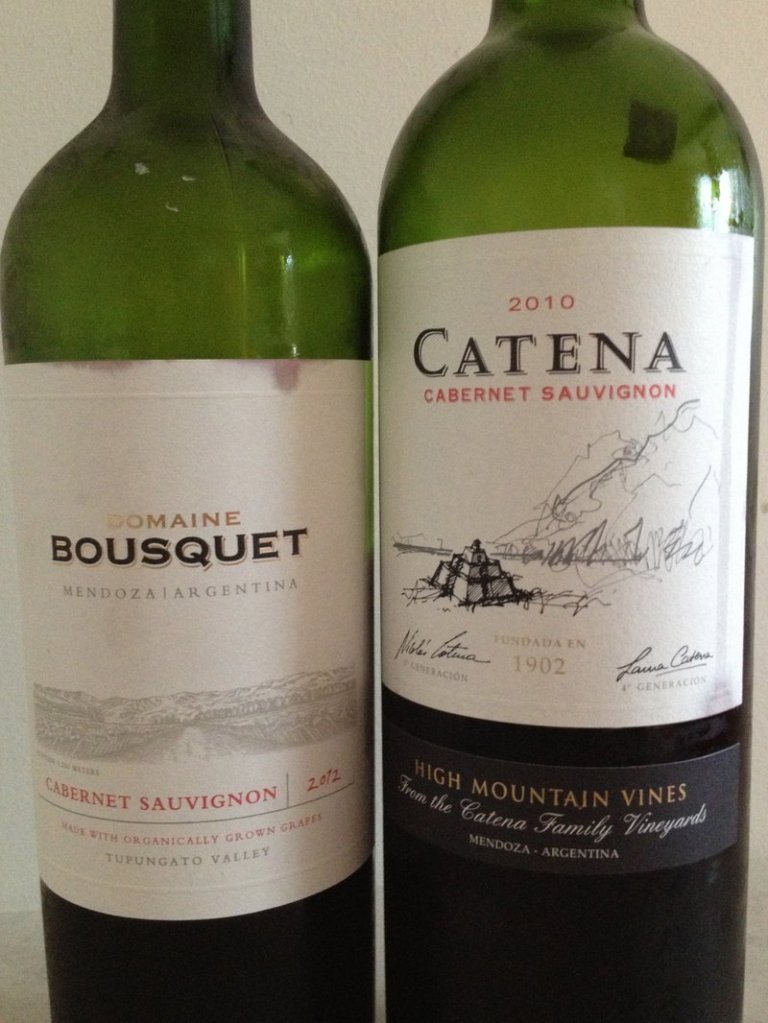Here’s something I bet you’ve never thought of: Argentine Cabernet Sauvignon. You may have drunk it, because that varietal is grown abundantly in the Southern Hemisphere. And Argentine Cabs — mostly from the enormous Mendoza uber-region, but Patagonia and elsewhere too — are relatively widely available.
But just because you’ve drunk it doesn’t mean you’ve thought of it: Consider it as distinct and representing the confluence of grape, place and method that is necessary for fermented grape juice to become wine.
Maybe I’m projecting; let’s just say that I hadn’t ever really thought of Argentine Cab. I’d seen it around. But I rarely drink Malbec, so (totally illogical and unfair) why drink anything else from where they make Malbec?
One reason for trying Argentine Cabs is that they can be very, very good, at doable prices. Just as with Malbec, a lot of Cab is indistinct. But when you come across a good one, it’s like finding a great hole-in-the-wall restaurant in a foreign city that you didn’t see mentioned in the guidebooks (or Yelp). The real deal.
And look, unless you run a hedge fund, it’s exceedingly difficult to find good Pinot Noir from Burgundy anymore; all the rich people have snatched it up. So the avid Pinot-lover with average income needs to explore Oregon and Germany (and quickly; prices for such Pinots are going up all the time).
Same goes for Bordeaux. There’s finally a new generation of people in Bordeaux who are struggling to work outside the brokerage system there that runs according to an official classification set in 1855. But that struggle is in its infant stages. And if you want to taste great French Cabernet Sauvignon (the majority grape in left-bank Bordeaux), you need to be rich and patient. Californian Cab is almost always expensive or gross.
So, what to do? Cab has an irresistible pull. We want to drink it. As someone in a position afforded by my work life to at least taste great Cab every once in a while, I have a somewhat different goal: I want to like it. I don’t want it overly green, overly tense, overly compacted, overly tannic, overly brutish. I want it approachable enough that I can drink recent or current vintages. I want it calmly expressive, loose-knit and at least somewhat nuanced. I don’t want to taste it and say, “Wow, that’s cool, and I can’t wait to drink it in 15 years when it’s ready.” I don’t eat steak very often, and I want it to be practical.
I’ve recently come across several Cabs from Argentina that meet these desires. The easygoing, everyday ones beat most similarly priced, mass-production, sourced-juice Cabs from California. The Argentine Cabs have better integration of fruit and spice, more intrigue in the flavors (less generic red fruit), and greater acidity.
Much of this is because of Argentina’s blessed climate and topography. High altitudes, copious sunshine and huge diurnal temperature shifts (up to 50 degrees in a single night) encourage full but slow ripening, concurrent with acid development. Low humidity provides an inhospitable environment for disease and rot, and makes it relatively easy to farm organically. Natural irrigation from snow melt plays into the theme of balance over bombast.
Some regions experience fierce winds across the vast, open vineyards that are 1,500 to more than 4,000 feet above sea level. That reduces yields, thereby packing more nutrients and flavor compounds into fewer grapes. And the phylloxera louse that devastated so many wine-growing regions across the globe never found a home in Argentina, so the majority of vines are planted on original, ungrafted rootstock. A hot-weather grape like Cabernet Sauvignon couldn’t be happier.
Same for me. I’ve found a way to enjoy one of the great varietals of the world, through wines that don’t demand deep thought or effort, but invite the sort of attention and appreciation their prices belie.
Bodegas Weinert Cabernet Sauvignon 2005, $22 (Easterly), Mendoza. This was the wine that did it for me. The first line of my initial tasting notes from a year ago read, in all capital letters, “THE GRAIL.” First of all, note the vintage. Then, taste. This is very old, soulful, earthy wine, truly Bordeaux-like. Aromas of cigar leaf and fig give way to clove, smoke and cigar on the tongue. The flavor arc is from deep, sweet summer-red fruit to smoke and incense, to grapefruit and a bitter, cocoa-like finish. It is so real-deal you want to hug the bottle; the sort of gnarly, chewy, dirt-fighter that Californians nostalgic for the old Napa style yearn for. “In limited availability now, but coming back into regular stock in November (possibly from the 2006 vintage).”
Nemesio Cabernet Sauvigon 2010, $12 (Crush), Patagonia. From the cooler-climate Patagonia region of the south, the Nemesio is more purple than red. With a black currant and licorice nose sweetened by Turkish coffee, the plum fruit is deep and pulsing. But in a region more suited to Pinot Noir than Cabernet, the wine comes out with a much more mineral profile than the Mendoza wines I’ve tasted: grill-charred vegetables, baking chocolate, and a finish like cast iron. A muscular, peppery wine, Nemesio is a lot of wine for twelve bucks, and not to be messed with.
Perhaps you’d like to start with something a bit … friendlier? There are two that stand out for me. The Santa Julia Cabernet Sauvignon 2011 ($10, Pine State), from organically grown grapes sourced from Mendoza is that ideal “everyday” wine: approachable but not boring. It is definitely a “made” wine: vanilla-scented from oak, boysenberry and blueberry, rounded tannins, nary a whisper of Cabernet’s challenging leafy qualities, smoothly milk-chocolate, few hairs out of place.
The Domaine Bousquet 2012 ($11, Wicked), also from organically grown grapes (hand-picked) from Mendoza, is a touch more jagged. There are plenty of berries, but met by white pepper, smoke, bacon and braised meat. And all in a rather dusty-textured package. Everyday wine, but a bit less controlled than Santa Julia.
The first tier of wines from Catena is a benchmark for middle-priced, bold, structured Argentine wines. (Nicola Catena is considered by many the founding father of Argentina’s fine wine industry, and the “Alta” and “Zapata” lines of Nicola’s descendants Nicolas and Laura are thought-ceasingly great).
Catena’s Cabernet Sauvignon 2010 ($21, Pine State) is rich, elegant, fearless wine, and yes, this is the time for steak. Well-integrated tannins bolster its profound, ripe fruit and toasty, soul-food geniality. A wine conducive to long, satisfied exhales.
Joe Appel works at Rosemont Market, but not all the wines mentioned in this column are necessarily sold there. His blog is soulofwine.com, and he can be reached at:
soulofwine.appel@gmail.com
Send questions/comments to the editors.




Success. Please wait for the page to reload. If the page does not reload within 5 seconds, please refresh the page.
Enter your email and password to access comments.
Hi, to comment on stories you must . This profile is in addition to your subscription and website login.
Already have a commenting profile? .
Invalid username/password.
Please check your email to confirm and complete your registration.
Only subscribers are eligible to post comments. Please subscribe or login first for digital access. Here’s why.
Use the form below to reset your password. When you've submitted your account email, we will send an email with a reset code.